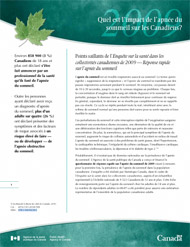sleep apnea is a serious pathology that causes repetitive arrests of respiratory flow during sleep. These pauses in breathing, or "apnea", last about 10 to 30 seconds and can occur several times during the night.
The most common type of sleep apnea is obstructive sleep apnea syndrome , which occurs when the upper airways become obstructed during sleep. Often the obstruction occurs at night when the soft tissues at the back of the throat collapse and block the airway. Loose throat muscles, narrow airways, a thick tongue, or excess fatty tissue in the throat can also contribute to the obstruction. Central apnea and mixed apnea are two other types of sleep apnea less frequent.
Signs and Symptoms of Sleep Apnea
Family members and spouses are often the first to notice the signs of sleep apnea. Many people with sleep apnea are unaware that they are snoring or short of breath at night. Those with the following signs should see a doctor.
- daytime sleepiness
- loud hum followed by silent pauses
- shortness of breath or choking during sleep
- morning headache
- irritability and moodiness
- poor concentration or memory loss
- loss of libido
- drowsy driving
Snoring is not synonymous with sleep apnea. It is true that people with sleep apnea tend to snore heavily, but there is a big difference between these two phenomena.
Untreated sleep apnea can cause serious health problems and lead to the following complications:
- high blood pressure
- stroke
- heart attack
- motor vehicle collision
- depression
- decreased libido
- workplace injury
Treatment
There are simple and effective ways to treat sleep apnea. Treatments vary depending on the severity of the apnea. Doctors can help determine the appropriate type of treatment. The most commonly used treatment is continuous positive airway pressure (CPAP). The VPPC consists of wearing a special mask that ensures that the throat is not blocked and prevents snoring and respiratory arrest.
To begin treatments, it is first necessary to determine if a person suffers from sleep apnea. People who experience any of the above signs or symptoms should see a doctor. The doctor will refer them to a sleep disorders center which will carry out a test during the night in order to examine their situation carefully. These people may need to undergo tests at home.
Lifestyle changes - such as weight loss and exercise - are one way to ease the symptoms of sleep apnea; they may also help reduce other risk factors for heart attack and stroke. If you have mild sleep apnea, some lifestyle changes could eliminate it completely; in more severe cases, they could alleviate the symptoms. Here are things you can do:
Losing weight
Being overweight increases the risk of developing sleep apnea. People who are overweight should consult their doctor for advice on how to lose weight safely. A weight loss of just 10% (which corresponds to 9 kg for a 90 kg man) can greatly reduce the number of respiratory arrests that occur each night.
To exercise
Exercise isn't just a great way to maintain a healthy weight, it's also a way to ensure restful sleep. (It's best not to exercise at least three hours before bedtime. Exercising hard before going to bed can cause insomnia.)
Stop smoking
Smoking can make sleep apnea symptoms worse as it irritates the throat and causes coughing at night. People who quit smoking have more energy to perform their daily physical activities.
Maintain a regular sleep schedule
Going to bed and getting up at approximately the same time every day promotes a good night's sleep. It is necessary to experience all stages of the sleep cycle, including the stages of light sleep and deep sleep, in order to feel rested. A regular sleep schedule prevents exhaustion, which could increase symptoms of sleep apnea.
Avoid consuming alcohol and sleeping pills
People who suffer from insomnia should have a cup of decaffeinated herbal tea or a glass of juice instead of drinking a glass of wine. Alcohol and certain medications (sleeping pills and analgesics) can cause abnormal relaxation of the muscles of the throat, which may lead to obstruction of the airways. Alcohol and drugs can also reduce the brain's ability to wake up and detect a lack of oxygen in the body. This reduction in capacity can lead to longer and more dangerous respiratory arrests. Reading a book and taking a hot bath are recommended ways to get rid of insomnia.
sleep on the side
Sleeping on your side rather than sleeping on your back can alleviate symptoms of sleep apnea. Gravity puts pressure on the tissues in the back of the throat and neck of people who sleep on their backs. This pressure can partially or completely obstruct the upper airway. The following are ways to practice sleeping on your side:
- lean a pillow against his back in order to remain lying on his side.
- Use a tennis ball. It involves sewing a pocket on the back of his pajamas and inserting a tennis ball into it. The ball will prevent the sleeper from turning over on their back during the night, the pressure exerted by the ball will encourage them to roll over onto their side.
Publications
- What is the impact of sleep apnea on Canadians? Highlights from the 2009 Canadian Community Health Survey - Sleep Apnea Rapid Response
- Life and Breath: Respiratory Diseases in Canada

